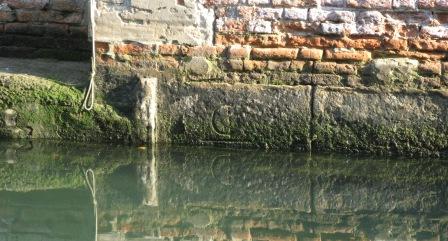It may be that your eye is not drawn wallward as you stroll along the canals of Venice when the tide is low.
Perhaps you don’t find the mats of squishy green clinging to the building foundations very appealing. Perhaps you don’t wish to notice how many small life forms are scurrying around, unhindered by that pesky water. Perhaps there is a general sort of sliminess that reminds you uncomfortably of just how biological the Venetian environment is, and how little the lagoon cares about posing for you and your romantic photographs.
But let’s say those things don’t bother you; let’s say you’re curious to find out what’s beneath the waterline, or almost. If you look carefully, you may very well see this:
This incised capital C with the line beneath it is called the “Comune Marino” (hence the “C”), which roughly means “average sea.” Or perhaps “sea average.” This one, as it happens, is in the canal just outside our little hovel.
Water level measurements were formalized in Venice in 1440 when the Water Authority (Magistrato alle Acque) began to measure the upper level of wet algae on canal embankments by carving the letter “C,” which indicated the normal high-tide level. Water fosters certain kinds of algae which flourish in an “intertidal zone”, which is alternately wet and dry, and the line of algae corresponds to the level of water. Obviously.
So “Comune Marino” refers to the line created by the algae, a line which clearly indicates the upper limit of the tide.
Good to know, but why? Because there are many situations in which an engineer would want to know where the average upper limit would be — if he was planning to build a bridge nearby, for example, or even an entire building.
So far, so general. Keep in mind, though, that in each place the “C” is a marker of the average sea level in that canal at that point. Its height only matters in relation to what’s next to it — the water level will be “high” (or low) compared to a building foundation or embankment. If the “C” appears to be going down (or the algae to be going up, like elevators in a French farce) it might indicate that the building is subsiding, or even that the canal is silting up and becoming shallower. Factors such as these all bear some influence on where the average sea level will be in that place and whether you find it innocuous or annoying.

An analysis of the displacement of the “algal belt” also gives engineers some idea of the long-term trend of apparent rising of the sea level. This is a subject that is far too great for this little post, but I merely note that the algae is playing its part in informing the world about the state of Venice.
Don’t be too quick, though, to think that just because there’s some algae above the “C” that the city is sinking inexorably into the lagoon. The algae has its own growing period (late winter to early autumn) and if the average high-tide level should rise one year, for one or many of several reasons, the line of algae will also rise. If it should go down the next year, there will be less algae at the previous level. Exceptional peaks in the high-tide level may cause temporary new growth, but it won’t necessarily survive the sunshine and dryness that returns when the tide level goes down.
Algae growth is also influenced by whether its location is on a sunny or shady side of the building, or whether the stone or brick it’s inhabiting is particularly porous.
Field observations have shown that the fluctuation in the height of the “algal front” is no more than 2 cm (7/10ths of an inch).
So all is well? Not really. One factor the Venetian engineers of 1440 didn’t have to deal with was “motondoso” — that’s a polite way of saying “water constantly splattering from the waves caused by motorboats.”
I’ll be devoting plenty of attention to motondoso on a future page, but I recommend that you draw conclusions very carefully about water level based solely on the line of algae. It’s highly likely that whatever spot you’re looking at is getting drenched by waves day and night, encouraging algae in an extravagant way, something that wasn’t happening back when they were busy carving “C’s” all over town.

The Daily Trivia: Regular measurements with instruments began in the 1870s. In 2004, mean sea level was found to be 25 cm (9 inches) higher than it was in 1897. Yet all water-level measurements continue to be based on the mean sea level in 1897.
We like to cling to the old ways here. Or something.




